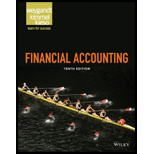
Concept explainers
Basic
The mathematical equation which shows the relationship among the different categories of a
Assets
Assets are the resources owned by a business to carry out production and sales activities. The assets are associated with a future economic value that can be expressed in terms of monetary values. All the assets are meant to provide future services or benefits. Examples include cash, accounts receivable, land, buildings, equipment, vehicles, investments, etc.
Liabilities
Liabilities are the obligations against assets that are to be fulfilled in the future. Most of the businesses borrow money or buy goods and services from a supplier on credit. This incurs a future obligation on the businesses, which is to be fulfilled in the future. Examples include loans payable, interest payable, accounts payable, wages payable, etc.
Stockholders’ equity
The amount invested to a business by its shareholder or the donated capital and earnings from operations less any dividends issued gives the stockholders’ equity. The stockholders’ equity gives the ownership claim on the total assets of a business. The amount left after satisfying the creditors, belongs to the stockholders’ claim on the assets. It also includes common stock and
Whether the transactions increased (+), decreased (-), or had no effect (NE) on assets, liabilities, and stockholders' equity.
Want to see the full answer?
Check out a sample textbook solution
Chapter 1 Solutions
Financial Accounting
- Financial Accounting Questionarrow_forwardsubject : General accountingarrow_forwardBH Company began the year with stockholders' equity of $320,000. During the year, the company recorded revenues of $460,000 and expenses of $310,000, and paid dividends of $30,000. What was Blue Horizon's stockholders' equity at the end of the year?arrow_forward

 AccountingAccountingISBN:9781337272094Author:WARREN, Carl S., Reeve, James M., Duchac, Jonathan E.Publisher:Cengage Learning,
AccountingAccountingISBN:9781337272094Author:WARREN, Carl S., Reeve, James M., Duchac, Jonathan E.Publisher:Cengage Learning, Accounting Information SystemsAccountingISBN:9781337619202Author:Hall, James A.Publisher:Cengage Learning,
Accounting Information SystemsAccountingISBN:9781337619202Author:Hall, James A.Publisher:Cengage Learning, Horngren's Cost Accounting: A Managerial Emphasis...AccountingISBN:9780134475585Author:Srikant M. Datar, Madhav V. RajanPublisher:PEARSON
Horngren's Cost Accounting: A Managerial Emphasis...AccountingISBN:9780134475585Author:Srikant M. Datar, Madhav V. RajanPublisher:PEARSON Intermediate AccountingAccountingISBN:9781259722660Author:J. David Spiceland, Mark W. Nelson, Wayne M ThomasPublisher:McGraw-Hill Education
Intermediate AccountingAccountingISBN:9781259722660Author:J. David Spiceland, Mark W. Nelson, Wayne M ThomasPublisher:McGraw-Hill Education Financial and Managerial AccountingAccountingISBN:9781259726705Author:John J Wild, Ken W. Shaw, Barbara Chiappetta Fundamental Accounting PrinciplesPublisher:McGraw-Hill Education
Financial and Managerial AccountingAccountingISBN:9781259726705Author:John J Wild, Ken W. Shaw, Barbara Chiappetta Fundamental Accounting PrinciplesPublisher:McGraw-Hill Education





